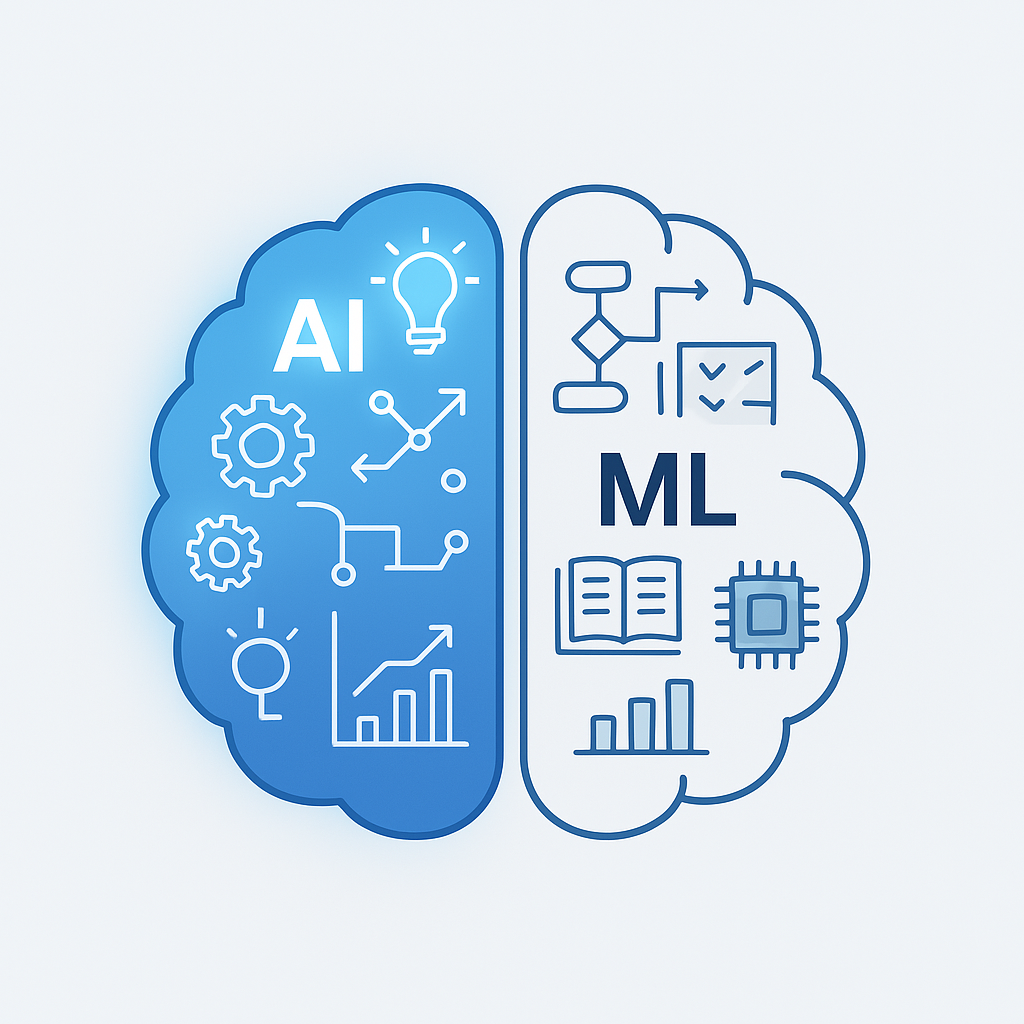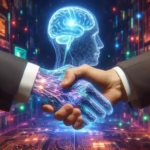
Artificial Intelligence vs. Machine Learning
🔍 Did You Know?
By 2030, AI is expected to contribute $15.7 trillion to the global economy. (Source: PwC)
You type a few letters, and your phone guesses the whole sentence. You open Netflix, and it magically knows what you want to watch next. You click on one product online, and suddenly every other website is showing you the same thing.
No, it’s not magic. It’s Artificial Intelligence (AI) and its brainy little sibling, Machine Learning (ML), working behind the scenes.
But wait, aren’t they the same thing? Not quite.
This article explores the meaning and working of them with simple analogy. Simple plain English.
Let’s get into it 👇.
Continue reading ⤵
Brain Analogy to understand

AI is the full brain — capable of thinking, planning, and solving problems.
ML is like one part of that brain — the learning and memory part that gets smarter the more experience it gains.
Let’s consider another Analogy.
🍕 Pizza Shop Analogy
- AI is the entire pizza shop. It takes orders, makes different types of pizzas, manages delivery, handles customer complaints—all kinds of “smart” decisions.
- ML is just one chef in the kitchen who learns over time how to make the best pepperoni pizza by watching others, tasting ingredients, and trying again after messing up.
So, AI = full system. ML = one learning part that improves with experience.
Now, let’s understand the definition.
What Is Artificial Intelligence (AI)?
At its simplest, AI is software designed to think and learn like a human. AI systems analyse data, spot patterns, and make decisions.
- Definition: AI enables computers to mimic human thought—planning, reasoning, problem‑solving, and learning.
Everyday Examples:
- AI Assistant: When you ask Siri or Google, “What’s the weather?” and get a spoken reply, that’s AI interpreting your question and fetching data.
- Chatbots: Automated customer‑service chats that understand your questions and respond in real time.
- Recommendation Engines: Netflix suggesting your next binge‑watch based on shows you’ve already seen.
What Is Machine Learning (ML)?
Machine Learning (ML) is a subset of AI focused on teaching machines to learn from data, rather than being explicitly programmed for every task.
Definition: ML algorithms that analyse large datasets to find patterns and make predictions.
Everyday Examples:
- Email spam filters: learn which messages you delete as spam and adjust over time to catch more junk.
- Voice Recognition: Apps like Alexa improve accuracy the more you speak to them.
- Photo Tagging: Google Photos recognizes your friends’ faces by learning from tagged images.
Credit‑Card Fraud Detection: Banks use ML to spot unusual spending patterns and block suspicious transactions.
How AI and Machine Learning Work Together (Made Simple)
- AI Without Machine Learning:
Imagine an old-school chatbot. It can only reply if you use exact words it’s been told to recognize. If you say, “Hi,” it replies “Hello.” But if you say, “Hey there,” it might go blank. It follows strict rules like a robot with flashcards. - AI With Machine Learning:
Now imagine a smart assistant like Siri or Alexa. It learns from your questions over time. Ask it a few different ways—“What’s the weather?” or “Do I need an umbrella?”—and it still gets what you mean. That’s machine learning in action—it improves by learning from you.
👉 Today’s smart systems usually mix different things:
- ML helps them recognize patterns (like your voice or habits),
- Natural language processing helps them understand and talk like humans,
- And sometimes, robotics brings it into the real world (like robots that move and react).
Key Differences at a Glance
| Aspect | Artificial Intelligence (AI) | Machine Learning (ML) |
| Scope | Broad field encompassing many techniques | Subset of AI focused on learning from data |
| Goal | Create machines that mimic human intelligence | Enable machines to improve performance via experience |
| Examples | Chatbots, expert systems, robotics | Recommendation engines, image recognition |
| Dependency | Can use ML, deep learning, rule‑based systems, etc. | Relies specifically on data and algorithms |
💡 Quick Tip: Spot the Difference in Apps
If it improves based on your usage (e.g., YouTube suggesting videos you actually watch), it’s using ML.If an app simply follows preset rules (e.g., an FAQ bot), it’s basic AI.
Careers in Artificial Intelligence (AI)
AI covers a broad scope, so careers often involve building intelligent systems that mimic human behavior.
Core Career Paths:
- AI Engineer – Builds and deploys AI models and applications.
- Robotics Engineer – Designs AI-powered robots for automation and interaction.
- Computer Vision Engineer – Works on AI systems that interpret visual information (e.g., facial recognition, object detection).
- Natural Language Processing (NLP) Engineer – Focuses on AI that understands and generates human language (e.g., chatbots, translators).
- Cognitive Scientist – Studies how AI can replicate human thinking and decision-making.
- AI Product Manager – Leads the development of AI-based products and services.
- AI Ethicist / Policy Expert – Focuses on the ethical, legal, and social impacts of AI.
- Speech Recognition Specialist – Builds systems that convert speech to text or control interfaces through voice.
📊 Careers in Machine Learning (ML)
Machine Learning careers are more data-focused and centered around creating models that learn from data.
🔍 Core Career Paths:
- Machine Learning Engineer – Designs and trains ML models, often in Python, using libraries like TensorFlow or PyTorch.
- Data Scientist – Analyzes large datasets to create models and extract insights using ML.
- Data Analyst (with ML skills) – Uses data and basic ML tools to create forecasts, trends, and decision-making tools.
- ML Researcher – Explores new machine learning algorithms and contributes to academic or industrial research.
- Deep Learning Engineer – Specializes in neural networks for tasks like image recognition, speech, and autonomous systems.
- Recommendation System Engineer – Builds personalized content or product suggestion engines (like Netflix, YouTube).
- ML Ops Engineer (Machine Learning Operations) – Focuses on deploying, monitoring, and maintaining ML models in production.
🧠 Overlapping / Hybrid Roles:
- AI/ML Consultant – Advises businesses on integrating AI/ML.
- Applied Scientist – Bridges ML models with real-world product usage.
- Research Scientist (AI/ML) – Works in both AI theory and ML experiments.
Conclusion: The Road Ahead
AI and ML are reshaping everything—from how you study to how companies do business. By grasping the distinction, you’ll be better equipped to leverage these technologies, whether you’re choosing a career path, picking the best apps, or simply staying safe online. Remember: AI is the broad goal of making machines smart, and ML is the practical method that teaches them to learn. Embrace both, and you’ll be ready for the future.
Want guidance on what to learn for any of these roles? …. Leave a comment.
📚 Reputable Resources
- Google Cloud – “AI vs. Machine Learning: How Do They Differ?” cloud.google
- Columbia AI Engineering – “Artificial Intelligence vs. Machine Learning” ai.engineering.columbia
- Coursera – “Machine Learning vs. AI: Differences, Uses, and Benefits” coursera
- Exabeam – “AI vs Machine Learning: Key Differences and Examples” exabeam




























Leave a Reply